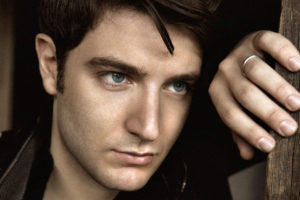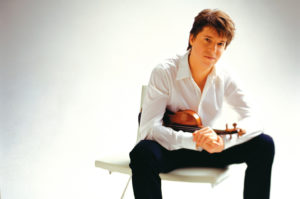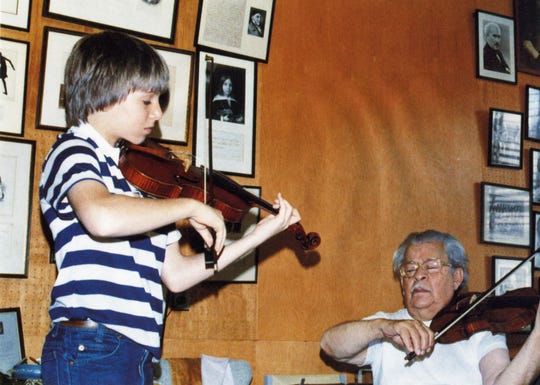BELL, BAX, BACH:
BEAUTIFUL, BRILLIANT, BREATHTAKING
I first saw Italian pianist Alessio Bax five years ago when he made his Los Angeles premiere playing Mozart’s Piano Concerto No. 24 with the L.A. Chamber Orchestra. I remember thinking he has all the right moves but had yet to incorporate personality into his work. While he demonstrated a youthful command of the oft-played concerto, he lacked oomph. Now 40, he appeared with the great violinist Joshua Bell at Disney Hall, and his style of playing still lacks soul; however, in this context as a partner to Bell, he was quite simply remarkable — unobtrusive, dutiful, professional, courteous and clean with a buttery smooth technique. I’m champing at the bit to how fierce his soloing is with Beethoven’s Piano Concerto No. 5, Emperor, when he joins Pasadena Symphony a week from this Saturday, Nov. 16.
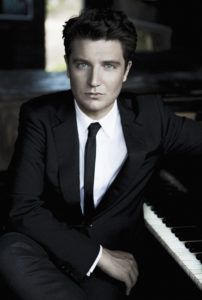 Bax’s limber, self-assured straightforwardness, glossy legato and faultless, smooth arpeggios are very well-suited to Bell’s trademark showmanship, which simply stunned. He never ceases to truly, truly impress. Bell, current director of Academy of St. Martins in the Fields chamber ensemble, doesn’t do as many big orchestral works as he used to; now it’s a lot of soloing and chamber. And For some strange reason — fires? the last game of the world series? a large venue? — Disney Hall with its crystal-clear acoustics wasn’t close to full. Woe to those who missed this program, especially in the jaw-dropping second half.
Bax’s limber, self-assured straightforwardness, glossy legato and faultless, smooth arpeggios are very well-suited to Bell’s trademark showmanship, which simply stunned. He never ceases to truly, truly impress. Bell, current director of Academy of St. Martins in the Fields chamber ensemble, doesn’t do as many big orchestral works as he used to; now it’s a lot of soloing and chamber. And For some strange reason — fires? the last game of the world series? a large venue? — Disney Hall with its crystal-clear acoustics wasn’t close to full. Woe to those who missed this program, especially in the jaw-dropping second half.
There are certain pieces of Franz Schubert’s that make palpably apparent the monumental tragedy of his life being cut short at only 31. Rondo in B minor, for violin and piano, Op. 70, D. 895 is one. Written in 1826 just a year before his death, Rondo is the only one of Schubert’s six violin-piano works to reach print during his lifetime. This Rondeau brillant is so delightfully experimental, changing meters and flavors throughout, that one can only wonder what Schubert’s unwritten future compositions would have been like. He did leave us with nearly 1,000 works, nearly all of which are marked by his distinctive genius. Bell’s sound remains exquisite here: so assured, so clean. The way his bow grabs the strings makes a depth and body of sound that is unmatched.
The Rondo isn’t the showiest piece for Bax, but César Franck’s Sonata in A for violin and piano, M. 8 (1886) sure is. Bax doesn’t show a heck-of-a-lot of interpretation here, and he certainly isn’t demonstrative — as opposed to Bell, who would finish phrases with a flourish and look at us with a face that said Didja hear that! But this is a very difficult work for piano, and Bax showed no problems with the inherent technical problems, which include frequent extremely extended figures and virtuoso runs and leaps, particularly in the second of four movements. He followed Bell wonderfully in the Recitativo, which is improvisational in nature, and free in both structure and expression.
Since Bax is on that gorgeous Steinway, we clearly don’t get a historically accurate rendering of Bach’s Sonata in C minor, for violin and keyboard, BWV 1017. Written before 1725, and revised in 1740, this is Bach with back-and-forth interplay for the duo, versus the harpsichord (here piano) merely a background for the violin’s artistry — so much so that those unfamiliar with this piece may not at first even recognize this as Bach but a later composer. The boys offer musicianship here that 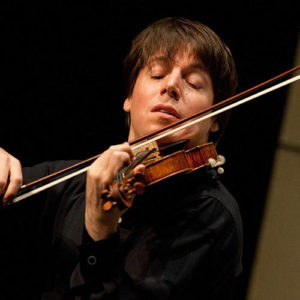 exudes tremendous warmth and vitality, emphasizing their obviously special chemistry. While Bell digs at the heart of the piece, Bax contributes effortless grace and poise. Can I say it is perfection? Well, yes, frankly — it is.
exudes tremendous warmth and vitality, emphasizing their obviously special chemistry. While Bell digs at the heart of the piece, Bax contributes effortless grace and poise. Can I say it is perfection? Well, yes, frankly — it is.
Franck composed his Sonata in A rather quickly, in August and September of 1886, as a wedding gift for the famous violinist (and Franck’s Belgian compatriot) Eugène Ysaÿe (ee-SIGH-yeh). The second and last piece after intermission was written by Ysaÿe. With Bax offstage, Bell, quite familiar with the Sonata for Solo Violin No. 3 in D minor, Op. 27, made it sound almost ethereal. Coincidentally, the 1923 work subtitled Ballade was the encore from 18-year-old Daniel Lozakovich after his triumphant take on Tchaikovsky’s Violin Concerto on the same stage last week. And they were completely different takes. Lozakovich was sweet, technically perfect, and light as an angel’s wings. But this is where extra years of life can help. Bell’s version made my eyes tear up. As Ysaÿe said, a master violinist “must be a violinist, a thinker, a poet, a human being, he must have known hope, love, passion and despair, he must have run the gamut of the emotions in order to express them all in his playing.” And that is Mr. Bell.
After a captivating, enchanting rendition of Clara Schumann’s Romance, Op. 22, for the first encore, Bell congenially made a six-degrees connection for us: Bach influenced Ysaÿe; Ysaÿe taught the Franck Sonata to Josef Gingold; and Bell learned the Franck sonata under Gingold’s tutelage (that’s Bell with Gingold above). The second encore was Henryk Wieniawski’s Scherzo-Tarantella for violin and piano op. 16 – a twinkling, dazzling, joyful romp of a virtuoso miniature. After this, Bell admitted to having two thoughts while playing the Wieniawski (“Which I guess I shouldn’t do,” he smiled boyishly): how long ago he was taught that piece, and the time he played it on The Johnny Carson Show in 1991. After nodding in appreciation with good humor and homeyness, “Thanks for coming,” we heard his arrangement of Chopin’s Nocturne in E-flat major for violin and piano. This one-time staple of the piano repertoire now pierces the heart in a different place.
Bell & Gingold photo from Indiana University
other photos courtesy LA Phil
Joshua Bell, violin & Alessio Bax, piano
in recital at Walt Disney Concert Hall
presented by LA Phil
reviewed on October 30, 2019
for future shows, visit LA Phil

